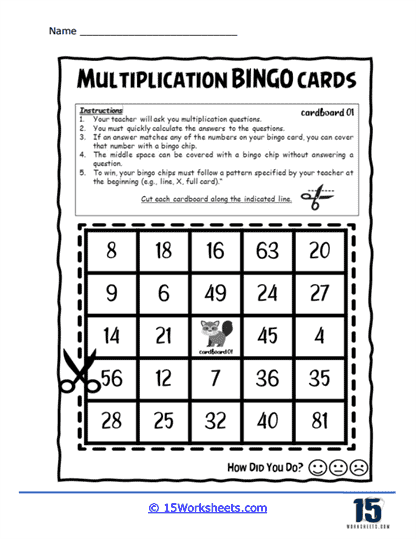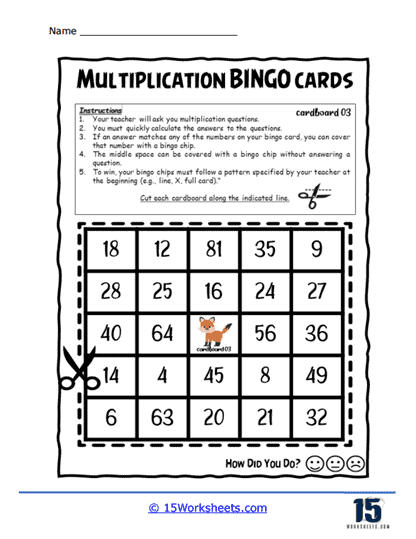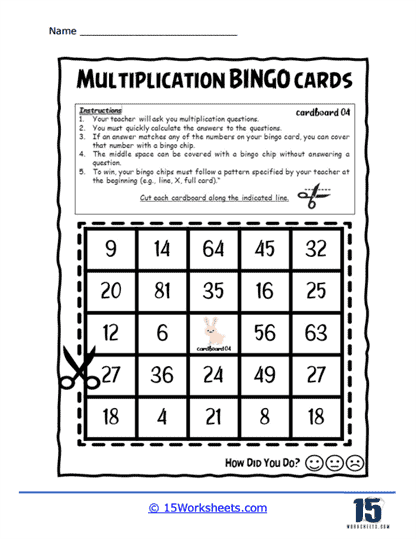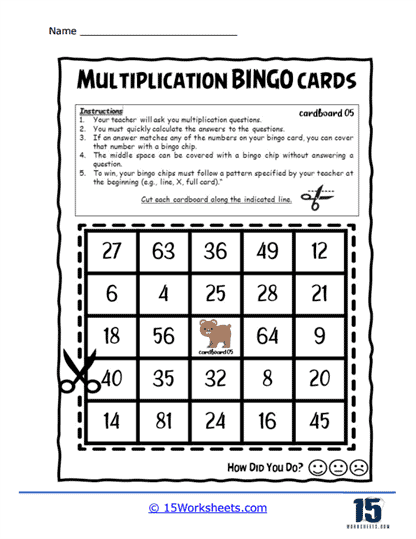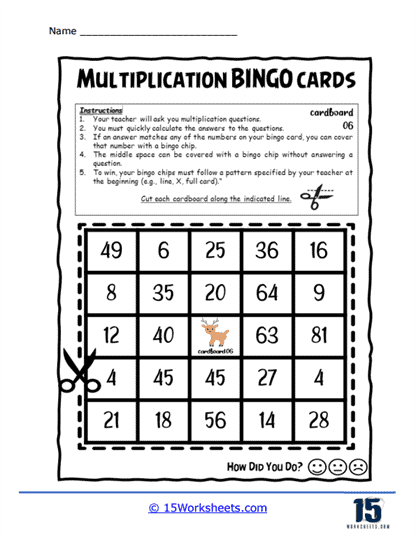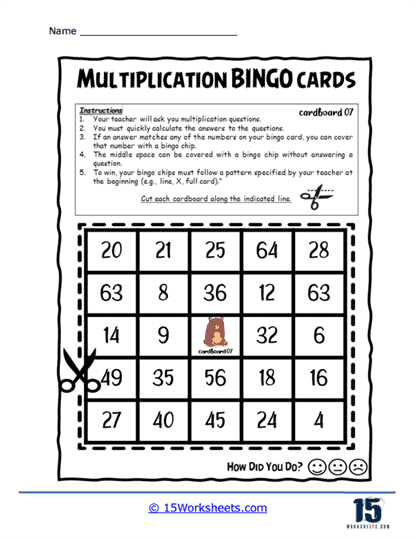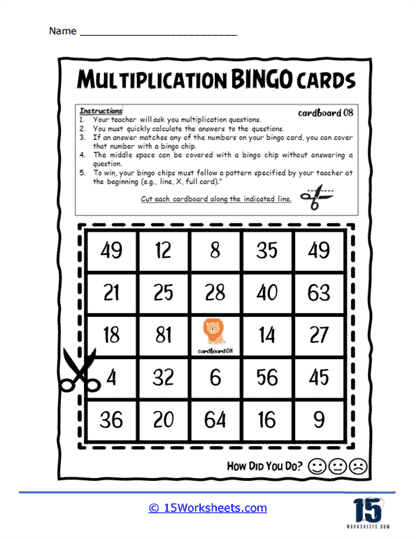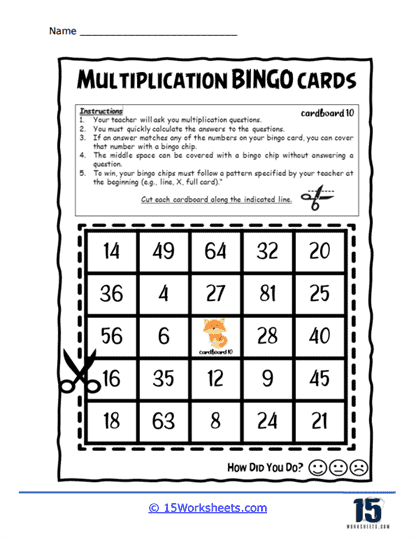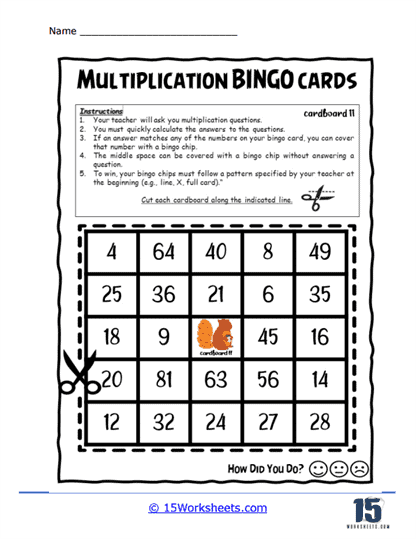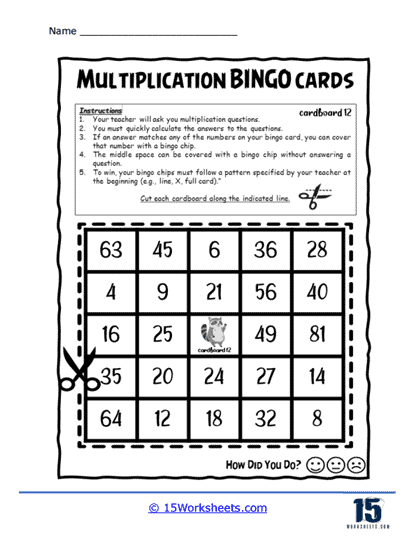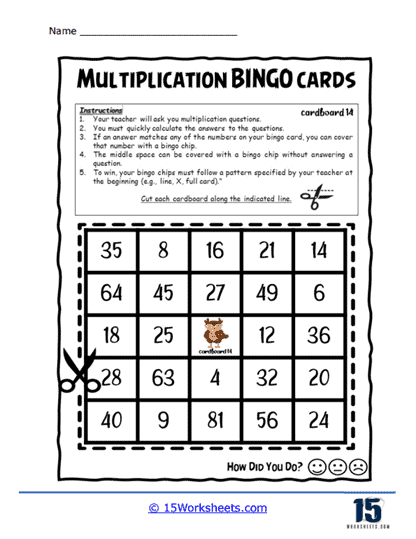Multiplication Bingo Worksheets
About These 15 Worksheets
These worksheets are a fantastic tool that teachers can use to make multiplication practice both interactive and engaging. These worksheets combine the classic game of bingo with multiplication problems, creating a fun and educational experience for students. Rather than traditional rote memorization or repetitive drilling, Multiplication Bingo introduces an element of excitement into learning multiplication, helping students become more motivated and focused. Teachers can use these worksheets to reinforce multiplication facts, assess students’ mastery of the multiplication tables, and provide a hands-on learning experience that enhances their number sense.
The setup for a Multiplication Bingo game is quite simple. Each student is given a bingo card that consists of a grid of numbers, typically the answers to various multiplication problems. The teacher will call out multiplication problems, and students must calculate the product in their heads or on scratch paper, then mark the correct product on their bingo cards. As in traditional bingo, the goal for students is to mark off a specific pattern on their cards, such as a row, column, diagonal, or a complete blackout, depending on the version of the game being played.
For younger students just learning their multiplication tables, the problems called out by the teacher can be limited to the 1-5 times tables, making the game easier and less intimidating. For older or more advanced students, the teacher can include more challenging problems from the 6-12 times tables, or even mix in multi-digit multiplication to push students’ skills further. This adaptability makes Multiplication Bingo an ideal resource for classrooms with diverse learning needs.
How Teachers Can Use These
Teachers can use these cards in several ways to enhance their math lessons. One of the most effective ways to use these worksheets is as a warm-up or a cool-down activity during math lessons. Starting the class with a few rounds of bingo can help get students’ minds focused on multiplication, and finishing the class with it can reinforce what they’ve learned in a low-pressure, fun environment. Since bingo is a game, it can also break up the monotony of traditional teaching methods and inject a sense of energy and competition into the classroom.
In a classroom, students may be at different levels of multiplication fluency. Bingo provides a unique opportunity for teachers to group students by their skill levels and use modified bingo cards. Advanced students can work with bingo cards that include more challenging multiplication problems, while students who are still building their multiplication confidence can use simpler problems. This way, every student is engaged and working at a pace that is suitable for their learning needs.
Multiplication Bingo can also be used to encourage peer learning and collaboration. Teachers can have students work in pairs or small groups to complete their bingo cards. This allows students to help one another with multiplication problems and share strategies for solving them. The collaborative nature of the game fosters a sense of teamwork and allows students to learn from each other in an informal, supportive setting. Additionally, group games can encourage shy or reluctant learners to participate without feeling singled out, as they can rely on their peers for support.
Using Multiplication Bingo Worksheets in the Classroom
Step 1 – Prepare the Bingo Cards
Begin by creating or printing out the bingo cards for each student. These cards should have a grid with random numbers that correspond to the products of multiplication problems. Make sure that the multiplication problems you plan to call out match the numbers on the cards. You can either use pre-made templates or create your own customized bingo cards that reflect the difficulty level of the class.
Step 2 – Introduce the Game to the Class
Explain the rules of the game to your students before you begin. Tell them that you will be calling out multiplication problems, and they need to calculate the answers in their heads or on paper. If the answer to the multiplication problem is on their bingo card, they should mark it off. Explain the win conditions, which could be completing a horizontal row, vertical column, diagonal line, or a full blackout card, depending on the type of bingo you’re playing.
Step 3 – Play the Game
Once students understand the rules, start calling out multiplication problems. To make the game more engaging, you can adjust the pace at which you call out the problems based on your students’ responses. Call out the problems clearly, and allow students enough time to work through the calculations before moving on to the next problem. Be sure to check in with students who may be struggling to keep up, offering them encouragement and extra support as needed.
Step 4 – Verify the Bingo
When a student calls out “Bingo,” stop the game and check their card to make sure they’ve marked off the correct answers. If the card is correct, declare that student the winner of the round. You can choose to reward the winner with a small prize, praise, or the option to be the next bingo caller. If the card is incorrect, continue the game until a valid bingo is found.
Step 5 – Adjust for Repetition or Skill Building
If you plan to play multiple rounds of bingo, be sure to mix things up to keep the game engaging. You can adjust the rules slightly, for example, by requiring a full blackout card or using different types of bingo cards that incorporate various types of multiplication problems. If students seem to be mastering the multiplication facts, you can introduce more complex problems or even incorporate division to make the game more challenging.
Step 6 – Reflect and Review
At the end of the bingo session, take a few moments to review some of the problems that were called out during the game. Ask students how they solved the multiplication problems and what strategies they used to find the answers. This helps reinforce the learning that took place during the game and gives students the opportunity to ask questions or clarify their understanding of the material.
Teachers can also incorporate multiplication bingo into small group activities. For example, after a lesson on a particular multiplication table, the teacher can assign groups of students to play a round of bingo using only that table. This provides immediate practice on what the students have just learned, and it allows the teacher to observe how well students are grasping the concept. Small group games also foster collaboration, as students can help one another figure out answers and strategize about their bingo cards.

